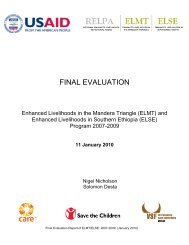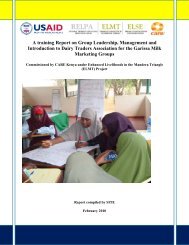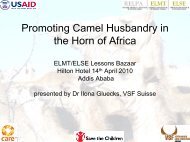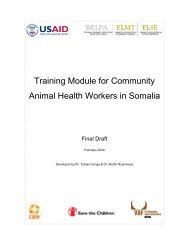care international in ethiopia – pastoral drop out study - ELMT Home
care international in ethiopia – pastoral drop out study - ELMT Home
care international in ethiopia – pastoral drop out study - ELMT Home
You also want an ePaper? Increase the reach of your titles
YUMPU automatically turns print PDFs into web optimized ePapers that Google loves.
Dire Wereda<br />
Dire is one of the Weredas <strong>in</strong> the Borana Zone of the Regional State of Oromia. It is located<br />
670 km s<strong>out</strong>h of Addis Ababa. It is the largest Wereda <strong>in</strong> the zone with an area of 12,722<br />
km 2 . There are 31 <strong>pastoral</strong> associations <strong>in</strong> the Wereda. Most of these associations were<br />
organized dur<strong>in</strong>g the Derg time. Recently, there had been some restructur<strong>in</strong>g done by the<br />
Cooperative Promotion Office of oromia, with technical support by VOCA, on the size and<br />
composition of the associations with the aim of <strong>in</strong>creas<strong>in</strong>g their efficiency to provide<br />
services to the residents of the Wereda. Some of the PAs <strong>in</strong> the Wereda border Kenya and<br />
people often cross the border to access graz<strong>in</strong>g and other social services.<br />
An arid and semi arid environment characterizes the agro ecology of the Wereda. It has a<br />
bimodal ra<strong>in</strong>fall pattern <strong>in</strong> which the ma<strong>in</strong> ra<strong>in</strong>fall is received <strong>in</strong> April-June and the other <strong>in</strong><br />
September-November. The Wereda is endowed with savanna type vegetation suitable ma<strong>in</strong>ly<br />
for cattle. In the more arid part there are highly nutritious browse species to support camels<br />
and goats.<br />
The human population of the Wereda is 112,262 (56,351 male and 55,921 female) with a<br />
household number of 22,452. Only 2% of the population lives <strong>in</strong> urban areas. The<br />
population density (ab<strong>out</strong> 9 persons / km 2 ) is too high for arid and semiarid systems. The<br />
Borana is the major ethnic group that occupies the Wereda. There are pockets of Gabra and<br />
Somali ethnic groups, which are spread th<strong>in</strong>ly over the most arid part of the Wereda. In<br />
most cases people’s livelihood is a reflection of the agro ecology <strong>in</strong> which they live, and the<br />
natural and man-made resources available at their disposal. Accord<strong>in</strong>gly, <strong>pastoral</strong>ism and<br />
agro <strong>pastoral</strong>ism are the dom<strong>in</strong>ant forms of production systems people depend for their<br />
liv<strong>in</strong>gs <strong>in</strong> the Wereda. Opportunistic cultivation is ma<strong>in</strong>ly practiced around towns and <strong>in</strong><br />
valley bottoms where the soil moisture content stays high for longer time.<br />
Dire is the center of the Borana <strong>pastoral</strong> production system where most of the tulla wells,<br />
which are the focal po<strong>in</strong>ts of the Borana system, are located. The Gumi Gayo assembly,<br />
which is the largest gather<strong>in</strong>gs of the Borana held every eight years, is hosted <strong>in</strong> a place called<br />
Gayo <strong>in</strong> Dire Wereda. Dire Wereda has ritual and production importance to all Borana. Dire<br />
14












